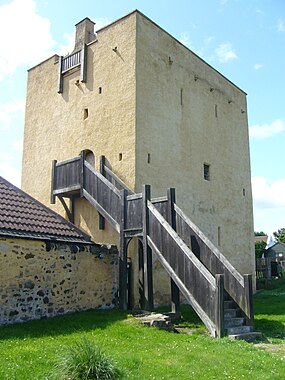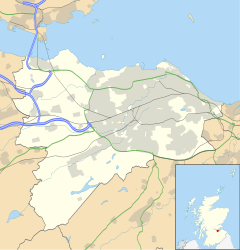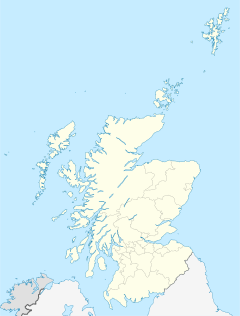Liberton is a suburb of Edinburgh the capital of Scotland. It is in the south of the city, south of The Inch, east of the Braid Hills and west of Moredun.
| Liberton | |
|---|---|
 Liberton Kirk | |
Location within the City of Edinburgh council area Location within Scotland | |
| OS grid reference | NT274696 |
| Council area | |
| Lieutenancy area |
|
| Country | Scotland |
| Sovereign state | United Kingdom |
| Post town | EDINBURGH |
| Postcode district | EH16 |
| Dialling code | 0131 |
| Police | Scotland |
| Fire | Scottish |
| Ambulance | Scottish |
| UK Parliament | |
| Scottish Parliament | |



Liberton Community council's area includes Liberton, Gracemount, Kaimes, Alnwickhill and Mortonhall.[1] Historically the parish covered a wide area and included Burdiehouse, Gilmerton, Niddrie and Straiton.[2]
Incorporated into the city in 1920,[3] the area was once home to Arthur Conan Doyle, who lived in a small cottage near the Braid Burn, which is now inside the grounds of the Cameron Toll Shopping Centre car park and is now a small school.
Increased development in the area from the mid 1970s to current times[when?] has seen Liberton develop into a popular choice for homeowners with areas such as Double Hedges, Alnwickhill and Howdenhall often representing better value for money than locations closer to the city centre.
In recent years[when?] once thriving community pubs and hotels have closed with the likes of the Liberton Inn, Northfield House Hotel and The Marmion, formerly The Captains Cabin, all having been converted to or planning permission being sought for retail premises or flats.[needs update]
Derivation
editThe name, of Old English origin and formerly written Libertun,[4] has generally been believed to signify 'Leper Town', the area being supposed at one time to have contained a small colony of lepers exiled from the city. However modern authorities have suggested it may more probably have meant ‘barley farm on a hillside’, from the Old English words hlith, hillside and bere-tūn, barley farm.[5][6]
This rural parish was split into Over Liberton and Nether Liberton, the latter centring on a water mill standing on the Braid Burn.
History
editThe suburb is home to a prehistoric standing stone just over 6-foot in height.[7]
A chapel of Liberton was granted to the monks of Holyrood Abbey in 1143 by MacBeth, Baron of Liberton. The latter is mentioned in the Charters of King David I from 1124. In 1240 a document records the transfer of the church from St Cuthberts in Edinburgh back to Holyrood Abbey and this control continued until the Reformation.[8]
In 1387 Nether Liberton was under control of Adam Forrester (whose family later owned Corstorphine) and is recorded (with Provost Andrew Yichtson) as benefactor of the repairs and rebuilding of St Giles Cathedral that year.[9]
At the time of the Reformation a church, dedicated to the Virgin Mary, already existed at Liberton, under control of Holyrood Abbey.[10]
The current Liberton Church, designed by James Gillespie Graham, was built in 1815 after the old church was burned beyond repair.[11] The graveyard contains a "table stone" to the south-west of the church bearing one of the earliest known sculpted depictions of ploughing.[12] A modern cemetery lies to the north-west of the older kirkyard. The war memorial at the western entrance (1920) is by Pilkington Jackson.
Liberton Tower is a well-preserved and restored late medieval (15th century) tower house standing to the south of the Braid Hills.[13] Liberton House nearby is a late 16th-century A-listed fortified house, also restored. The house is open to the public free of charge by appointment only.[14][15]
Liberton became part of Edinburgh on 1 November 1920.[16]
Present-day Liberton
editAlthough the area is mostly residential, it has a riding school and stables, which take advantage of the nearby Braid Hills to offer pony trekking. Also in the area is Liberton High School, Gracemount High School and several primary schools (Liberton, St John Vianny, Gracemount and St Katherine's). Sporting activities are represented by Liberton Bowling Club (Website) based opposite the Kirk, a Golf club off Gilmerton Road and a Rugby Union club at Double Hedges Park.
Southfield Sanatorium once occupied Southfield House; Ellen's Glen House community hospital (2000) was built in the grounds to meet twenty-first century NHS Lothian needs. Liberton Hospital opened in 1906 and currently specialises in geriatric medicine.
Demographics
editThe Liberton/Gilmerton ward of the city had 37,672 inhabitants at the 2021 Census.
| Ethnicity | Liberton/Gilmerton Ward | Edinburgh[17] |
|---|---|---|
| White | 82.6% | 84.9% |
| Asian | 10.2% | 8.6% |
| Black | 2.7% | 2.1% |
| Mixed | 2.4% | 2.5% |
| Other | 2.1% | 1.9% |
Liberton Cemetery and Kirkyard
editLocal family names include Speedy, Flockhart, Inch, Tod, Plenderleith, Borrowman and Torrance.
Monuments and interments
edit- Tom Aiken (1872–1943) Scottish billiards champion
- William Inglis Clark FRSE (1855–1932), chemist and mountaineer (stone vandalised)
- W. Barbrooke Grubb (1865-1930), missionary and author
- Arthur Robertson Cushny FRS (1866–1926), physiologist
- Henry John Dobson (1858–1928), artist from St John's Town of Dalry, Kirkcudbrightshire, father of artists Henry Raeburn Dobson and Cowan Dobson.
- Prof Robert Flint (1838–1910), theologian and philosopher
- Charles Edward Green (1866–1920), author of the Encyclopaedia of Agriculture
- A monument to the children who died at Dr Guthrie's School
- Rev George William Jones FRSE (1879–1918), academic, killed as a pilot in the First World War
- Rt Hon Sir John McNeill (1795–1883) and Lady Emma Augusta Campbell
- John McVeagh (d.1861), civil engineer
- Rev Joseph Moffett DD (1885–1962), theologian
- Charles Roy Nasmith FRSE (1882–1954) US consul
- Robert Payton Reid ARSA (1857–1945), artist
- Ethel Constance Roussel (d.1917), widow of the artist Arthur Melville (in the family plot of David Croall of Southfield)
- Lt John Thornton (1780–1870), participant in the Battle of Nivelle
- Prof Findlater Simpson (1842–1923), theologian
Ministers of Liberton
editLiberton was a relatively important rural charge.
- Alexander Forrester 1562 to 1566 formerly a Canon at Holyrood Abbey, probably the son or nephew of Alexander Forrester a Laird of Liberton in 1536
- Andrew Blackhall 1564 to 1567
- Thomas Cranstoun 1569 to 1570 and 1574 to 1579
- John Davidson 1579 to 1584
- Michael Cranstoun 1586 to 1590 translated to Cramond Kirk
- James Bennet 1591 to 1609
- John Adamson 1609 to 1623 became Principal of Edinburgh University
- John Cranstoun briefly in 1624 before translating back to South Leith Parish Church
- Andrew Learmonth 1627 to 1639
- Archibald Newton 1639 to 1657
- Andrew Cant 1659 to 1673 translated to Trinity College Church
- Ninian Paterson 1674 to 1683 deposed for "immorality"
- Robert Farquhar 1683 to 1687
- Alexander Cumin(g) 1687 to 1689
- James Webster 1689 to 1691
- Gideon Jacque 1692 to 1695
- Samuel Semple 1697 to 1742
- John Jardine 1741 to 1750 translated to Lady Yester's Church
- David Moubray 1751 briefly
- Thomas White 1751 to 1789
- James Grant MA 1789 to 1831
- William Purdie 1831 to 1834
- James Begg 1835 to 1843 from Lady Glenorchy's Church left at the Disruption of 1843 Moderator of the Free Church in 1865
- John Stewart 1843 to 1879 Father of the Church
- William Henry Gray 1880 to 1897 Moderator in 1888[18]
- Robert Burnett 1898 to ?
Other notable residents
edit- James Goodwillie FRSE (1866–1953) mathematician, born and raised in Liberton[19]
- Archie Scott (1918–2019), first-class cricketer
Trivia
editDunedin, New Zealand, a sister city of Edinburgh's, has a suburb called Liberton.
See also
editReferences
edit- ^ Peggie, Chris. "Liberton and District". The City of Edinburgh Council. Retrieved 27 March 2023.
- ^ "Liberton from The Gazetteer for Scotland". scottish-places.info. Retrieved 27 March 2023.
- ^ ReDrawing Edinburgh: The Edinburgh Boundary Extension Centennial 1920 Project, City of Edinburgh Council
- ^ New Statistical Account of Scotland (Family History Library book 941 B4sa, series 2 vol. 1)
- ^ A. D. Mills. "Liberton." A Dictionary of British Place-Names. 2003.
- ^ Ross, D.(2001) Scottish Place-names Edinburgh: Birlinn, p. 141
- ^ "Edinburgh, Liberton, Ravenswood Avenue". canmore.org.uk. Historic Environment Scotland. Retrieved 17 April 2023.
- ^ Cassell's Old and New Edinburgh; vol. 6, ch.38
- ^ Cassell's Old and New Edinburgh; vol. 6, ch. 38
- ^ Fasti Ecclesiae Scoticanae; by Hew Scott
- ^ The Buildings of Scotland; John Gifford, Colin McWilliam, David Walker, Christopher Wilson
- ^ Stephen Dickson; research whilst surveyor of graveyards and cemeteries for CEC
- ^ "Liberton Tower". Liberton Tower. Archived from the original on 15 September 2017. Retrieved 2 April 2014.
- ^ "Canmore". Retrieved 5 December 2016.
- ^ "Projects". Groves-Raines Architects. Retrieved 2 April 2014.
- ^ Edinburgh and its Environs:Wardlock Guide
- ^ "Liberton / Gilmerton". citypopulation.de. Retrieved 24 August 2024.
- ^ "Liberton parish, Midlothian".
- ^ Biographical Index of Former Fellows of the Royal Society of Edinburgh 1783–2002 (PDF). The Royal Society of Edinburgh. July 2006. ISBN 0-902198-84-X.
External links
edit- Media related to Liberton, Edinburgh at Wikimedia Commons
- Aboon the Kirk | Interesting places in Liberton, The Liberton Association, 2020
- Liberton Golf Club
- Liberton Bowling Club

